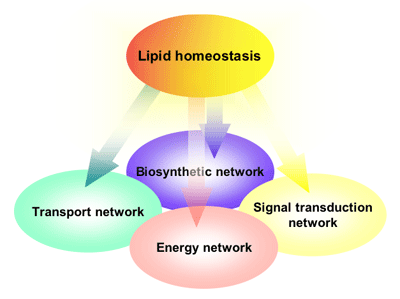| |
 |
 |
| |
| Home | Project | People | Research | Education | Archive | |
 |
Environmental Genomics |
[English | Japanese ] |
 |




 |
![Chemical Genomics]](../img/btn_e_chemo_01.gif)  |
 |
Masato Umeda
Professor,
Division of Multidisciplinary Chemistry,
Institute for Chemical Research, Kyoto University |
Lipid Homeostasis and Genome Network
Recent progress in lipid metabolome analyses have shown that more than 10,000 molecular species of lipids are present in biological membranes and a vast amounts of structural and functional information are stored in each lipid molecule. Although a primary function of membrane lipids is the formation of the permeability barrier of cells, they are enzymatically converted into a wide variety of bioactive lipid species such as prostagrandins, leukotriens, platelet-activating factor, cannabinoids, lysophosphatidic acid, inositol lipids, ceramide, playing a crucial role in "Signal transduction network" that control cellular metabolism and organism's activities. Lipid molecules are not tethered to the site of their synthesis, but are actively transported and assembled into different cellular membranes and body tissues. Specialized lipid sorting and transport machineries form a "Transport network of lipids", which distributes lipid molecules to various cellular membranes and tissues. During cell division, cells must double their components for daughter cells and extensive degradation and synthesis of lipids occur during membrane biogenesis. Although it is reasonable that this event should coincide with the synthesis of other cellular components such as DNA and proteins, the biochemical mechanisms of the cell-cycle regulated "Biosynthetic network of lipids" that coordinate the synthesis of every molecular species of lipids are largely unknown. Finally, the lipids are a major source of energy in the organisms. Some lipid metabolites play an important role as a fuel sensing and signaling molecule, forming an "Energy production and storage network", which controls energy homeostasis of the organisms.
It is becoming clear that the multi-layered regulatory networks of the lipid metabolism, transport and signal transduction, so called the "Lipid homeostasis",
are formed at the cellular and whole organism levels. Dysfunction
of the lipid homeostasis has been suggested to cause various
diseases in the modern society, such as obesity, diabetes,
atherosclerosis, cancer, infectious diseases, and neurological
disorders. New advances in genomics and proteomics approaches
have already begun to aid in the fight against the leading
cause of mortality worldwide. We have undertaken molecular
biology, cell biology, and behavioral genetics approaches
to elucidate the role of molecular motion of membrane lipids
in animal morphogenesis and thermoregulation. In this project,
we would also employ bioinformatics approaches to understand
the fundamental principles underlying the lipid homeostasis.
Such an integrated approach also encompass the elucidation
of novel targets for drug and gene therapy of the diseases.

|
Top
| 2007 | 2006 | 2005 | |
|
|

